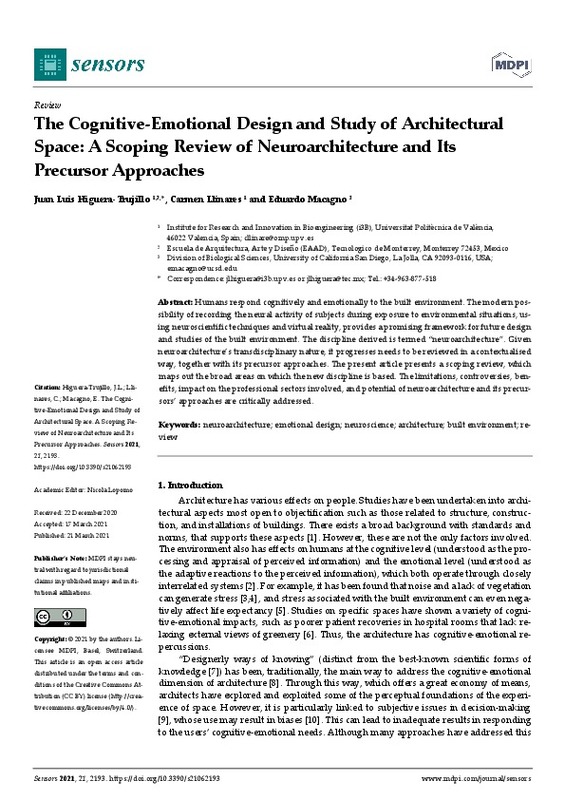JavaScript is disabled for your browser. Some features of this site may not work without it.
Buscar en RiuNet
Listar
Mi cuenta
Estadísticas
Ayuda RiuNet
Admin. UPV
The Cognitive-Emotional Design and Study of Architectural Space: A Scoping Review of Neuroarchitecture and Its Precursor Approaches
Mostrar el registro sencillo del ítem
Ficheros en el ítem
| dc.contributor.author | Higuera-Trujillo, Juan Luis
|
es_ES |
| dc.contributor.author | Llinares Millán, María Del Carmen
|
es_ES |
| dc.contributor.author | Macagno, Eduardo
|
es_ES |
| dc.date.accessioned | 2022-01-30T19:06:24Z | |
| dc.date.available | 2022-01-30T19:06:24Z | |
| dc.date.issued | 2021-03 | es_ES |
| dc.identifier.uri | http://hdl.handle.net/10251/180364 | |
| dc.description.abstract | [EN] Humans respond cognitively and emotionally to the built environment. The modern possibility of recording the neural activity of subjects during exposure to environmental situations, using neuroscientific techniques and virtual reality, provides a promising framework for future design and studies of the built environment. The discipline derived is termed "neuroarchitecture". Given neuroarchitecture's transdisciplinary nature, it progresses needs to be reviewed in a contextualised way, together with its precursor approaches. The present article presents a scoping review, which maps out the broad areas on which the new discipline is based. The limitations, controversies, benefits, impact on the professional sectors involved, and potential of neuroarchitecture and its precursors' approaches are critically addressed. | es_ES |
| dc.description.sponsorship | This work was supported by the Ministerio de Economia, Industria y Competitividad of Spain (Project BIA2017-86157-R). The first author is supported by funding from Ministerio de Economia, Industria y Competitividad of Spain (PRE2018-084051), and the Academy of Neuroscience for Architecture (John Paul Eberhard Fellow). | es_ES |
| dc.language | Inglés | es_ES |
| dc.publisher | MDPI AG | es_ES |
| dc.relation.ispartof | Sensors | es_ES |
| dc.rights | Reconocimiento (by) | es_ES |
| dc.subject | Neuroarchitecture | es_ES |
| dc.subject | Emotional design | es_ES |
| dc.subject | Neuroscience | es_ES |
| dc.subject | Architecture | es_ES |
| dc.subject | Built environment | es_ES |
| dc.subject | Review | es_ES |
| dc.subject.classification | ORGANIZACION DE EMPRESAS | es_ES |
| dc.title | The Cognitive-Emotional Design and Study of Architectural Space: A Scoping Review of Neuroarchitecture and Its Precursor Approaches | es_ES |
| dc.type | Artículo | es_ES |
| dc.identifier.doi | 10.3390/s21062193 | es_ES |
| dc.relation.projectID | info:eu-repo/grantAgreement/AEI/Plan Estatal de Investigación Científica y Técnica y de Innovación 2013-2016/BIA2017-86157-R/ES/EL DISEÑO DEL AULA PARA POTENCIAR LOS PROCESOS COGNITIVOS DEL ALUMNADO: UNA PROPUESTA METODOLOGICA PARA EVALUAR LAS VARIABLES LUZ, COLOR Y FORMA/ | es_ES |
| dc.relation.projectID | info:eu-repo/grantAgreement/AEI//PRE2018-084051//AYUDA PARA CONTRATO PREDOCTORAL PARA LA FORMACION DE DOCTORES-HIGUERA TRUJILLO, JUAN. PROYECTO: EL DISEÑO DEL AULA PARA POTENCIAR LOS PROCESOS COGNITIVOS DEL ALUMNADO UNA PROPUESTA METODOLOGICA PARA EVALUAR LAS VARIABLES LUZ COLOR Y FORMA/ | es_ES |
| dc.rights.accessRights | Abierto | es_ES |
| dc.contributor.affiliation | Universitat Politècnica de València. Departamento de Organización de Empresas - Departament d'Organització d'Empreses | es_ES |
| dc.description.bibliographicCitation | Higuera-Trujillo, JL.; Llinares Millán, MDC.; Macagno, E. (2021). The Cognitive-Emotional Design and Study of Architectural Space: A Scoping Review of Neuroarchitecture and Its Precursor Approaches. Sensors. 21(6):1-47. https://doi.org/10.3390/s21062193 | es_ES |
| dc.description.accrualMethod | S | es_ES |
| dc.relation.publisherversion | https://doi.org/10.3390/s21062193 | es_ES |
| dc.description.upvformatpinicio | 1 | es_ES |
| dc.description.upvformatpfin | 47 | es_ES |
| dc.type.version | info:eu-repo/semantics/publishedVersion | es_ES |
| dc.description.volume | 21 | es_ES |
| dc.description.issue | 6 | es_ES |
| dc.identifier.eissn | 1424-8220 | es_ES |
| dc.identifier.pmid | 33801037 | es_ES |
| dc.identifier.pmcid | PMC8004070 | es_ES |
| dc.relation.pasarela | S\431976 | es_ES |
| dc.contributor.funder | AGENCIA ESTATAL DE INVESTIGACION | es_ES |
| upv.costeAPC | 1963,23 | es_ES |








